The best wine grape varieties: descriptions and characteristics
The purpose of growing technical (wine) grape varieties is to prepare various types of wine (white, pink, red), as well as juices and other drinks (for example, compotes). Naturally, the wine varieties are quite different from the table ones in their very appearance, namely: the brushes and fruits are noticeably smaller, although the overall yield of the bush is quite high (comparable). But what actually distinguishes technical varieties from table varieties is a high percentage of sugar (over 18-20%, about 25-28%) and juice in the berry (over 75-85%). And they don't need to be covered for the winter!
Below you can find detailed descriptions and characteristics of the best and most popular technical grape varieties of all colors (white, pink and black).
By the way! From universal (table-technical) varieties, delicious drinks (wine) are also obtained, therefore, some attention will be paid to them.

Content
Best white grape wine varieties: top 3
The following popular white technical grapes (in alphabetical order) are suitable for making wine:
Crystal
The variety was created on the basis of a complex crossing of Amur and Challozi Lajos with Villard Blanc. Hungarian selection.
Variety with medium vigor.
Leaves are dark green in color, strongly cut.
The brushes are medium, of moderate density, their weight varies within 170-220 g.
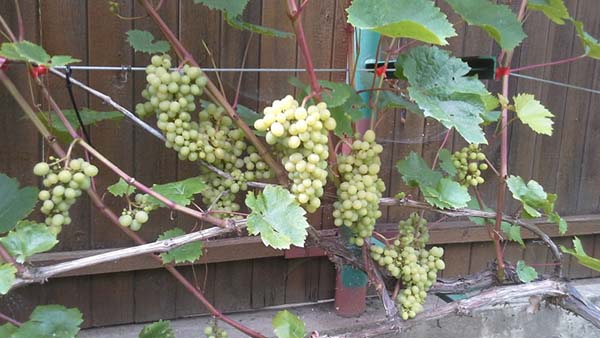
The fruits are yellow-green or white with a prune bloom. Medium size, oval, each weighing from 1.5 to 2.1 g. The pulp is juicy, the peel is strong. The taste is harmonious.

Dry wines of the sherry type are produced from Kristall.
Characteristics of the Crystal variety:
- ripening period - 110-115 days;
- sugar accumulation - 17-18%;
- acid content - 6-7 g / l;
- the ratio of fruitful shoots - 85-90%;
- the ratio of bunches per shoot is 1.3;
- optimal load - 60 eyes;
- recommended pruning of vines - 3-4 eyes;
- frost resistance up to -29 degrees.
Important! This variety does not tolerate thickening of plantations, which threatens with shedding of the ovary, disheveled brushes and loss of yield.
Benefits:
- Excellent ripening of a one-year vine - 90-100%.
- Ripe brushes remain on the shoots for a long time (until frost).
- Not affected by gray mold.
- High resistance to powdery mildew - 2.5 points, to mildew - 2 points.
Disadvantages:
- With a low level of sugar accumulation, the acidity decreases to 3.5-4 g / l, which significantly worsens the quality of the wine.
Odessa Muscat
The variety was bred by crossing the early blue Muscat and Pierrelle. Selection IV&V them. V.E. Tairova (Ukraine).
Growth strength is above average.
Odessa Muscat is distinguished by tassels of 130-190 g, cylindrical conical shape. Their density is average, often with one wing.
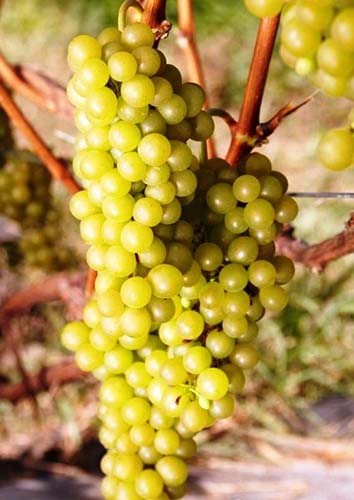
The color of the berry is yellowish green. Fruits are round, measuring 14.2 x 13 mm and weighing about 2 grams. The taste is harmonious with a rich nutmeg aroma. The pulp is slimy, the skin is dense, but thin.
It is used for the preparation of white table and dessert wines, sparkling nutmeg and juices.
Characteristics of the variety Muscat Odessa:
- ripening period - 130-140 days;
- sugar content - 18.6-22%;
- acidity - 5.5-8.7 g / l;
- the ratio of fruitful shoots is 80-87%;
- the number of bunches - 1.2;
- optimal load - 30-35 eyes;
- pruning vines - 3-4 eyes;
- frost resistance up to -24 degrees.
Advantages:
- Highly resistant to mildew (2.5 points) and oidium (2 points).
- Good maturation of shoots.
Platovsky
The variety is obtained by crossing on the basis of the qualities of the Gift of Magarach and Zalandede. Breeding VNIIViV them. ME AND. Potapenko (Russia).
Bushes with medium vigor.
Platovsky is characterized by a cylindro-conical shape of clusters of moderately dense structure, the mass of which reaches 200 g.

White-pink color. The fruits have a juicy pulp with a thin but dense skin. Weight of 1 berry is 2-3 g. Taste properties of the variety are harmonious.
Characteristics of the Platovsky variety:
- ripening period - 110-115 days;
- sugar accumulation - 20%;
- acidity - 9 g / l;
- fruitful shoots - 85%;
- bunch ratio - 1.3;
- optimal load - 60-80 eyes;
- recommended pruning of vines - 3-4 eyes;
- frost resistance up to -29 degrees.
Important! To accelerate the ripening process of fruits, Platovsky needs the timely removal of the foliage covering the bunches.
Advantages:
- High tasting index of dry table wine (8.4 points)
- Good ripening of shoots (about 80%).
- High resistance to mildew (2 points), gray rot (2 points), powdery mildew (2.5 points), average - tophylloxera (3 points).
- The crop lasts 30 days on the bush without losing its qualities.
Disadvantages:
- Mandatory removal of stepchildren, sterile and underdeveloped shoots is required.
- Poorly picks up wood.
- Needs rationing (no more than 2 bunches per shoot).
- Needs a special rootstock - Kober 555.
Other white technical grades
The following technical varieties of white grapes (in alphabetical order) are also suitable for making wine:
- Bukovinka;
- Gewurztraminer;
- Malvasia;
- Muscat;
Odessa Muscat is one of the most popular Muscat for wine. Golodrygi Muscat (a universal variety) is also popular.
- Gift of Magarach;
- Firstborn of Magarach;
- Semillon;
- Solaris;
- Sauvignon Blanc;
- Riesling;
For example, Riesling Maharach.
- Citron Magaracha;
- Chenin Blanc.
Of course, there are other varieties of white wine grapes, but they are exclusively regional (such as Aligote, Pinot blanc or Pinot gris), so it will be extremely difficult to get their cuttings (seedlings) and grow them (if at all possible).
The best versatile and wine varieties of pink grapes: top 4
Naturally, among the rose grapes, there are also varieties that are suitable both for fresh consumption and for making wine. They are also called table-technical or universal (alphabetically):
The note! Gurzuf pink and Muscat pink, rather, can be attributed to black (blue) varieties, because they just have a dark red shade of fruits, but it is their names that determine the place in the classification (by color).
Gurzuf pink
A versatile variety.
Obtained by crossing the varieties Muscat VIRa and Magarach 124-66-26. Selections of illegal armed group "Ampelos" (Ukraine).
Vigorous bushes with bisexual flowers.
The clusters at Gurzufsky are cylindrical or cylindrical-conical, winged, medium or large in size, loose, with an average weight of about 250 g.
By the way! The taste is very reminiscent of the Hamburg Muscat variety.
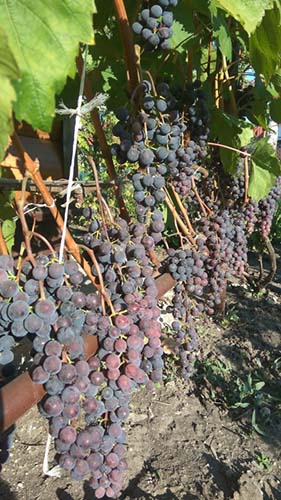
The berries are dark red. The fruits are round in shape, differ in fleshy pulp. The peel of the fruit is dense. The palate is pleasant and harmonious, with a pronounced nutmeg aroma. The number of seeds in fruits is from 3 to 4 pieces.
Recommended for making high quality pink dessert wines.
Characteristics of the Gurzuf pink variety:
- ripening period - (110-115 days) early;
- yield - 150 g / ha;
- sugar accumulation - 25-29%;
- acidity - 6-7 g / l;
- optimal load - up to 40 eyes;
- recommended pruning of vines - 2-4 eyes;
- frost resistance up to -25 degrees.
Advantages:
- Good tasting score (7.9-8.0 points).
- Field resistance to common diseases (mildew, oidium, gray mold).
- Good maturation of the young vine.
Minuses:
- Relatively weak resistance to phylloxera.
- The overall taste is spoiled by a thick rind that remains in the mouth with a herbaceous taste.
Diana
An old versatile variety from North America.
It is characterized by bushes of weak and medium vigor.
Has small whole leaves. The lower part of the leaf plates with a dense edging.
The bunches are cylindrical, medium in size and dense in structure.

Rounded small fruits are characterized by slimy pulp with a pronounced isabelle taste.
Characteristics of the Diana variety:
- ripening period - mid-late September;
- frost resistance up to -30 degrees.
Advantages:
- The flowers are bisexual, so there are no problems with the ovary.
- The yield is above average.
- Differs in high resistance to fungal diseases.
- No need to cover for the winter.
Lydia (Isabella pink or red, Lydia pink)
A versatile variety. It belongs to the isabel group.
It is characterized by a medium to strong growth rate.
Suitable for growing on a personal plot for gardening a gazebo. Also suitable for landscaping balconies, walls of houses.
Leaves can be of different sizes and shapes (three-, five-lobed), slightly dissected, there is a felt edge below.
The clusters are medium (120-200 grams), characterized by a conical or cylindro-conical shape, branching and a loose structure.

The berries are medium (about 2-3 grams), round, dark red, with a lilac wax bloom. The skin is firm, the flesh is slimy, there is a specific strawberry aroma.

Lydia responds well to fertilization and is not susceptible to waterlogging of the soil.
Characteristics of the Lydia variety:
- ripening period - 140-150 days;
- yield - 100-120 c / ha;
- sugar accumulation - 18-19%;
- acidity level - 5.5-9.3 g / l;
- frost resistance up to -29 degrees.
Important!The variety needs constant pinching and chasing, otherwise the plantings thicken strongly, which somewhat slows down the ripening of the fruits. However, in general, the Lydia variety is very unpretentious.
Benefits:
- Has bisexual flowers.
- Does not need treatment from mildew, oidium, because has field resistance against these diseases.
- One-year shoots ripen well.
- Drought tolerant.
- Delivers increased hydration.
- Relatively salt-resistant.
Disadvantages:
- Susceptible to calcareous chlorosis.
- Phyloxera resistance is insignificant.
- As the berries ripen, the stalks weaken.
It is used for the preparation of dessert and strong wine materials, as well as juice.
Pink Muscat (Red Muscat, Muscat Rouge de Fronttignan, Moscato Rosso di Madera)
It is a variation of White Muscat. Pure wine variety.
Bushes of medium vigor. The flower is bisexual.
A cluster of medium size (14-18 cm long, 7-10 cm wide), cylindrical or cylindrical-conical, dense. The mass of the bunch is 108-204 g.

The berry is dark red, covered with a thick waxy coating, small or medium-sized (11-18 mm long, 10-17 mm wide), round. The skin is thin but firm. The pulp is juicy, tender, with a strong nutmeg aroma. There are 2-4 seeds in a berry.
It is used for the preparation of vintage liqueur Muscat wines: South Coast Pink Muscat, Dessert Pink Muscat, Magarach Pink Muscat, which have an original aroma with hints of Kazanlik rose, as well as sparkling wine materials and table wines.
Characteristics of the Muscat pink variety:
- ripening period - 140 days (average);
- yield - 60-80.3 c / ha;
- sugar accumulation - 17.9-24.2 g / 100 ml;
- acidity - 4.8-9.1 g / l;
- frost resistance up to -15-18 degrees.
Advantages:
- Ripening of annual shoots is good or satisfactory.
Pink Muscat is less whimsical to soil and climatic conditions than White Muscat. Better adapted to various soil moisture conditions.
Disadvantages:
- Average yield.
- The grape variety is not resistant to mildew, strongly affected by powdery mildew.
- It is damaged by phylloxera and grape leafworm.
- It often cracks and decays.
- Differs in low frost resistance.
Also, among the technical pink grape varieties, the following are especially distinguished:
- Oleg (Diamant);
- Rkatsiteli pink;
- Traminer pink (Tramin).
Best black grape wine varieties: top 4
It is not surprising that among black grape varieties there is the largest number of technical varieties intended for making red wine (alphabetically):
August
The variety was bred on the basis of Kazachka and SV 12-309. Breeding VNIIViV them. ME AND. Potapenko (Russia).
Forms vigorous bushes.
Augustus has small (110-120 g) brushes of conical shape, dense and medium loose structure.
The berries are dark blue with a prune bloom. Round small fruits weigh 1.3-1.7 g. Taste qualities of the variety are harmonious with an unobtrusive note of nutmeg. The pulp of the fruit is juicy, fleshy, with a dense skin, the juice is not colored.

Characteristics of the Augusta variety:
- ripening period - 128-130 days;
- sugar content - 23-24%;
- acidity - 9 g / l;
- fruiting coefficient - 1.6;
- yield - 100-110 c / ha (with a planting scheme of 3 by 1.5 meters);
- optimal load - 20-25 eyes;
- permissible trimming - 3-4 eyes;
- winter hardiness up to -24 ... -25 degrees.
This grape is used for dry and dessert wines.
Advantages:
- Not a bad dry wine tasting score (7.5 points).
- High resistance to powdery mildew (1.5 points), good to mildew (2.5 points), medium to phylloxera (3.5 points).
- High rate of rooting of cuttings.
- Compatible with different stocks, but Kober 5BB or 101-14 is better.
Disadvantages:
- Very much stepson (chases stepsons just with terrible force).
He loves watering very much - there are more bunches, without watering it grows very medium.
Aliyevsky
Bred on the basis of the Viorica and Startovy varieties. Selections of the Moscow Agricultural Academy K. A. Timiryazeva.
Differs in medium or vigorous bushes.
The shade of a ripe young vine is nutty. Alievsky is distinguished by large, slightly dissected leaves with a strongly corrugated blade. On the reverse side of the leaf plates, there is a small bristly edge.
Aliyevsky develops cylindro-conical dense brushes of medium size and weighing 130 g.
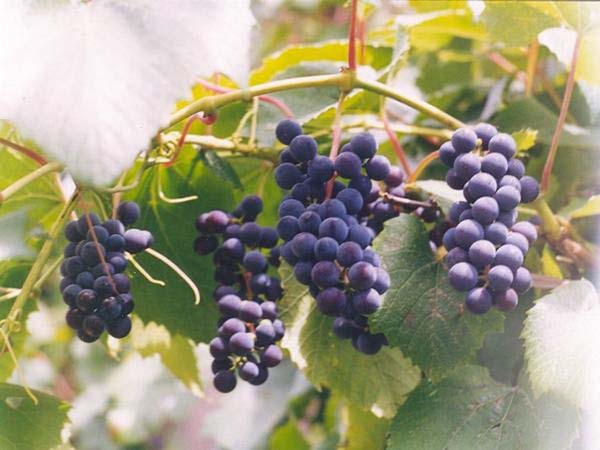
The color of the berries is blue-black. The pulp is juicy, soft, without aroma. The rind is firm.
Used for the preparation of dry and semi-sweet red wines.
Characteristics of the Alievsky variety:
- ripening period - 130-135 days;
- yield - 110-140 c / ha;
- the ratio of fruitful shoots - 85%;
- fertility coefficient - 1.5;
- optimal load - 45-50 kidneys;
- frost resistance up to -26 ..- 28 degrees.
Advantages:
- The flower is bisexual.
- Ripening of the vine is good.
- Resistant to major diseases.
Alpha
Bred in the USA by crossing V.labrusca x V.riparia.
The variety is characterized by medium and vigorous bushes.
Differs in large sharp-toothed three-lobed leaves with an average degree of dissection.
Forms medium-sized cylindrical or cylindrical-conical brushes with a dense to medium loose structure. The average weight of a bunch is 120 g, the maximum is 220 g.
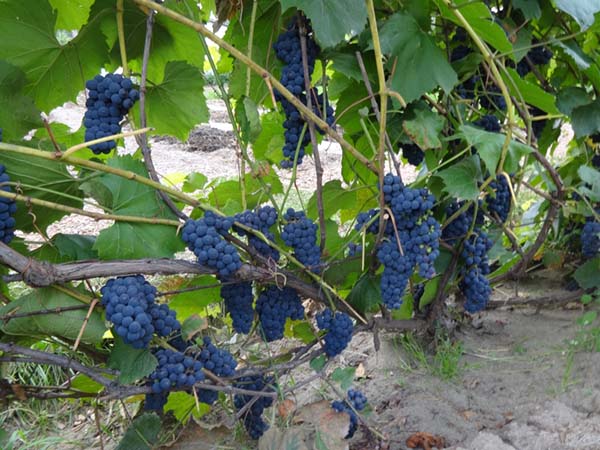
The color of the berries is black with a reddish-purple tint; they are also covered with a thick waxy bloom. The fruits are round and medium in size. The skin is dense, firm, easily separated from the pulp. The mucous flesh of the berries has a pronounced very sharp sour taste, with a well-pronounced strawberry aroma, it is poorly separated from the seeds.
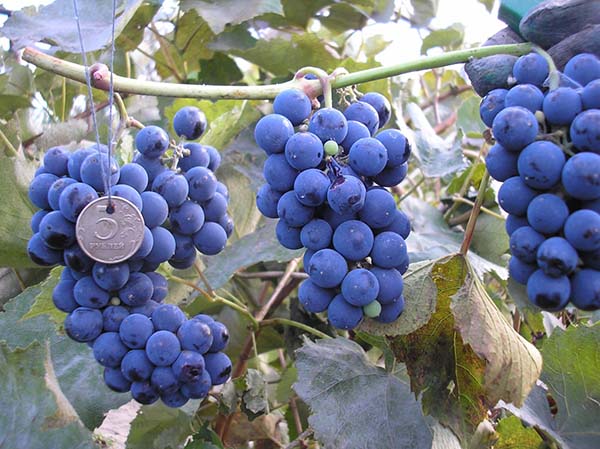
By the way! Alpha is great for landscaping gazebos, balconies and walls.
Characteristics of the Alpha variety:
- ripening period - 140-145 days;
- yield 150-180 c / ha;
- sugar content - 15-16%;
- acidity - 10-11 g / l.
Advantages:
- It is characterized by bisexual flowers, so pollination does not cause any difficulties.
- Weakly susceptible to diseases: relatively resistant to mildew, anthracnose.
- The ripening of the vine is very good.
- Perfect as a rootstock for varieties with low frost resistance.
Disadvantages:
- It is affected by spots and pests.
- High acidity.
Taiga
The bush is very vigorous. Female type of flower.
Can be used for landscaping.
Conical bunches, loose, small or medium, weighing up to 250 g.
The berries are dark blue, weighing 2.5-4 grams. With a light nutmeg aroma (sometimes there is a Labrusca flavor), it is very rich in pectin substances.
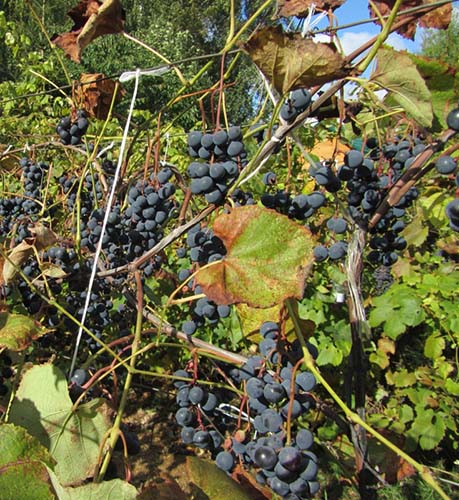
Characteristics of the Taezhny variety:
- ripening period - 130-135 days;
- the average number of clusters per shoot is 2.5-3.5.
- sugar accumulation - 17-24%
- frost resistance up to -28-35 degrees.
Advantages:
- High productivity.
- The berries can hang without decay (even in the rain) for 1.5 - 2.5 months.
- Comprehensively resistant to all fungal diseases.
Disadvantages:
- Still, sometimes it is struck by mildew.
- We need a pollinator, preferably Alpha.
- Due to overload, it picks up sugar poorly.
Other black technical grades
Also, among the black grape varieties that are suitable for making wine, there are:
- Alminsky;
- Bastardo Magarachsky;
- Vesta;
- Dove;
- Pomegranate Maharach;
- Danko;
- Ilyichevsky early;
- Ruby Golodrigi;
- Cabernet Dorsa;
- Cabernet Pearls Clogs;
- Cabernet Cortis;
- Cabernet Jura;
- Lada;
- Livadia black;
- Marshal Foch;
- Merlot;
- Muscat Blau;
- Don Muscat;
- Mendeleum;
- Odessa black;
- Regent;
- Rondo;
- North Saperavi;
- In memory of Golodriga;
- Pinotin;
- Tavkveri Magaracha;
- Early purple;
- Black Pearl.
The best table-technical (universal) black grape varieties: top-4
Among the black grapes, there are versatile varieties that are suitable both for fresh consumption and for making wine.
Isabel
Natural hybrid between Labrusca and Winifer species.
Isabella is characterized by vigorous bushes.
Ideal for landscaping gazebos and other buildings.
The leaves are three-lobed, large and medium in size, deep green in color. On the reverse side of the plates there is a bluish edge.
The berries are dark blue with a bluish tint. Grape clusters reach a mass of 140 g, their shape is cylindrical with wings, the structure is of medium density, in some cases loose.
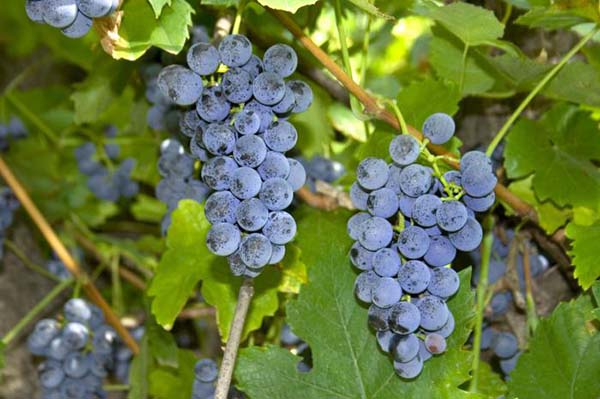
The fruits can be either oval or round, with a dense, firm skin. Isabella's flesh is slimy, with a pronounced strawberry aroma.
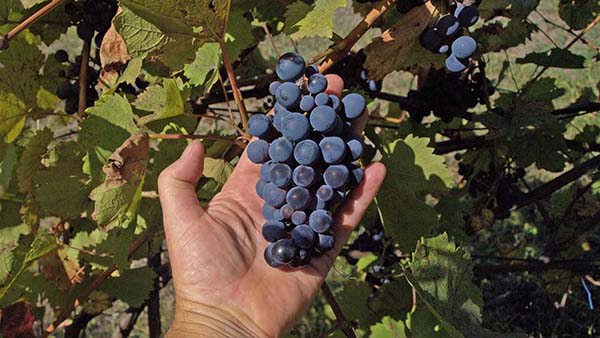
Suitable both for fresh consumption and for the preparation of ordinary wines.
Characteristics of the Isabella variety:
- ripening period - 150-180 days;
- sugar accumulation - 16-18%;
- acidity - 6-7 g / l.
- yield - 65-70 c / ha;
It prefers to grow on low-calcareous soils.
Advantages:
- The flowers are bisexual, which gives excellent self-pollination.
- Differs in high resistance against fungal diseases and phylloxera.
- It tolerates high humidity well.
By the way! Produces fruitful shoots from old wood and from replacement buds, which allows you to get a harvest even if the main (main) buds freeze.
Disadvantages:
- It does not tolerate drought very well (the growth force of the bush sharply decreases and leaves may fall).
Important! When the plantings are thickened, the grapes are affected by mildew.
Muscat of Hamburg (Muscat de Hamburg)
Obtained by crossing Frankenthal and Muscat of Alexandria. The variety was bred in England for greenhouse culture.
It is characterized by bushes of medium vigor.
The brush sizes reach 18-20 cm in length and 11-17 in width, conical, branched, characterized by a loose structure. The weight of one bunch varies from 168-267 g. The stem of the bunch is of medium length (4-6 cm).
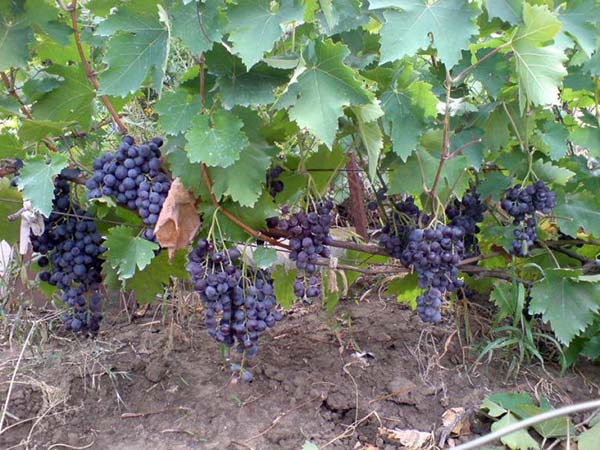
The berries are dark blue (violet-blue) with waxy pollination. Fruits are round, less often oval, 12-26 mm long, 11-17 mm wide, and weigh 3-4 grams. Their taste is pleasant, with a strong nutmeg flavor. Muscat of Hamburg has a juicy, fleshy pulp with a firm peel. There are 2-3 large seeds in the berry.

Compotes, juices, preserves and marinades made from berries of this variety are distinguished by their high taste.
Characteristics of the Muscat Hamburg variety:
- ripening period - 150 days;
- sugar accumulation 16-22%;
- acidity - 6-8 g / l;
- the ratio of fruitful shoots - 67%;
- bunch ratio - 1.58;
- frost resistance up to -18-19 degrees.
Note! This variety belongs to a group with potentially high but very unstable yields.
Advantages:
- High tasting performance (9 points)
- The flowers are bisexual, which guarantees the ovary in any weather.
- It is almost not damaged by the grape leafworm.
- Wasps don't eat.
- It tolerates transportation well and can be stored for up to 2-3 months.
It grows well and bears fruit on the southern and southwestern slopes with light loamy, sandy loam and sandy soils.
Disadvantages:
- Very low frost resistance.
- Susceptible to almost all diseases, unstable to mildew, oidium, gray mold, bacterial cancer, phylloxera.
- Prone to peas.
- Annual shoots ripen satisfactorily, but with excess moisture and lack of heat, it is bad.
Zilga
Bred on the basis of a complex crossing of the Smuglyanka variety with a mixture of pollen from Dvietes zila and Yubileiny Novgorod. Selections P. Sukatniek (Latvia).
Bushes are vigorous.
Note! The variety is great for gardening gazebos.
Brushes are cylindrical, large, weighing 320-400 g, often with a wing, generally have a dense structure, but sometimes they are loose.

It has a uniform dark blue color. Oval fruits are large in size, weighing 4.1-4.3 grams. The pulp is slightly slimy, with a slight isable aroma.
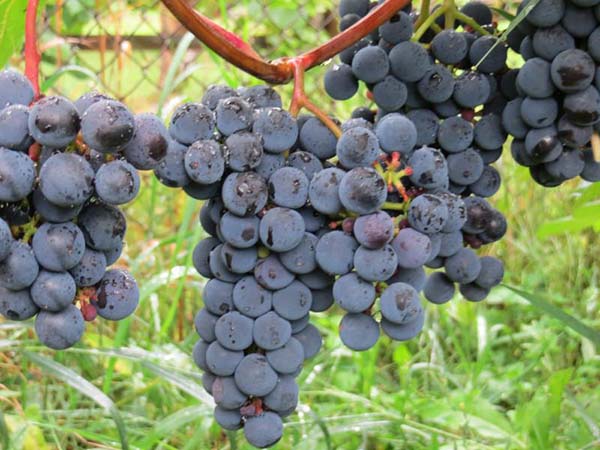
Characteristics of the Zilga variety:
- ripening period - 102-108 days;
- sugar accumulation - 18-22%;
- acidity - 4.5-5 g / l;
- the ratio of bunches is 1.5-1.9;
- shoots ratio - 80-85%;
- load - 30-40 eyes;
- optimal pruning of vines - 3-4 eyes;
- frost resistance up to -25 degrees.
Advantages:
- The crop is preserved for a long time on the bush without loss of quality.
- Resistant to major diseases (mildew, oidium and gray rot).
- Shoots ripen very well.
- Not damaged in transit.
- Compatible with different rootstocks.
Disadvantages:
- Average tasting assessment of the quality of fresh fruits (7.1 points).
Other popular black versatile grapes:
- Redness;
- Ruby Maharach.
Thus, now you know which varieties of technical grapes should be planted on the site, near a house or a gazebo, in order to green the dacha buildings in the summer and prepare delicious multi-colored drinks (in particular, white, pink or red wine) in the fall. In addition, if you plant a universal grape, then it will be suitable for food.

